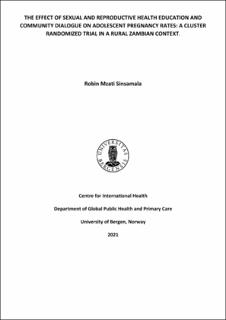THE EFFECT OF SEXUAL AND REPRODUCTIVE HEALTH EDUCATION AND COMMUNITY DIALOGUE ON ADOLESCENT PREGNANCY RATES: A CLUSTER RANDOMIZED TRIAL IN A RURAL ZAMBIAN CONTEXT.
Master thesis
Permanent lenke
https://hdl.handle.net/11250/2761236Utgivelsesdato
2021-05-18Metadata
Vis full innførselSamlinger
- Master theses [138]
Sammendrag
Background: To date Zambia and other sub-Saharan Africa (SSA) countries are still burdened by high rates of adolescent pregnancy. Sexual and reproductive health (SRH) education has shown impact on knowledge and attitude, but inconsistent effects on behaviour and biological SRH outcomes. Similarly, cash transfer (CT) interventions have shown mixed impacts on adolescent pregnancy. Teenage pregnancy is a strongly association with poverty, school dropout and little SRH knowledge. This study, therefore, measures the effectiveness of economic support and of a combined economic and community intervention on the incidence of pregnancy among adolescents in Zambia. Methods: This cluster randomized controlled trial included schools in rural Zambian communities as clusters. In total 157 clusters and 4922 girls from grade 7 in the selected schools were recruited. Study arms comprised: 1) economic support, 2) combined economic support and community intervention, 3) control. We used data collected up to the 7th follow up to measure the incidence of pregnancy by the end of the intervention period in 2018. The outcome was compared between the three study arms using intention to treat analysis. Hazards Ratios (HR) were calculated using Parametric Weibull regression models with time since randomization as a time scale. Results: The participants mean age was 14.1 (SD 1.34). The difference in pregnancy incidence between the combined intervention and control was 17% (HR 0.83 (95% CI 0.68-1.00) and between economic support and control was 16% (HR 0.84 (95% CI 0.69-1.02), and the confidence interval for both estimates included the null value. There was no difference between the combined intervention versus economic support only on pregnancy incidence (HR 0.99 (95% CI 0.83-1.17). Conclusion: This study indicates that the small differences found in pregnancy incidence between the intervention and control arms was largely due to the economic support intervention. SRH education and community dialogue had no added impact on incidence of pregnancy by the end of the intervention. Trial registration: ISRCTN registry: ISRCTN12727868, (4 March 2016).
